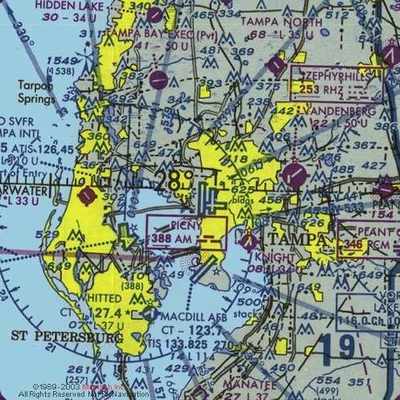Weather Often Clogs Arrival, Departure Corridors
 Those living around Tampa, FL are no
strangers to inclement weather, particularly in the summertime.
Late afternoon thunderstorms are the norm during the hottest
months... and hurricanes remain a distinct possibility, as well
(case in point: as of Monday afternoon, Tropical Storm Fay was
forecasted to hit the area later this week, as at least as Category
1 hurricane.)
Those living around Tampa, FL are no
strangers to inclement weather, particularly in the summertime.
Late afternoon thunderstorms are the norm during the hottest
months... and hurricanes remain a distinct possibility, as well
(case in point: as of Monday afternoon, Tropical Storm Fay was
forecasted to hit the area later this week, as at least as Category
1 hurricane.)
"Thunderstorms take out a lot of area in Florida, where you also
have to take in account the military training areas off both
Florida coasts," says Larry Newman, a Boeing 757 pilot and chairman
with the Air Line Pilots Association. "That doesn't leave a lot of
airspace."
Fortunately for pilots in the area, air traffic controllers say
they're used to routing planes around hazardous weather. The Tampa
Tribune recently chronicled some of their efforts, in a rather
detailed report.
Five arrival and five departure corridors are used by
controllers at Tampa International Airport... and it's not uncommon
for a storm band to block at least one of those routes, forcing ATC
to route traffic into the airport around the storms. To ward off
traffic backups -- both on the ground, and in the air --
controllers employ a variety of methods that allow more planes to
operate within areas that are clear.
One of those plans is the "cap and tunnel" strategy. Arriving
traffic is placed in a racetrack-shaped holding pattern, and then
vectored by ATC onto a single approach corridor. Inbound traffic is
then directed to fly lower than usual, to allow outbound planes to
overfly arriving traffic with at least the required 1,000 foot
vertical separation.
"Thunderstorms block arrival and departure corridors, so we
often are forced to use one corridor," Mark Kerr, a senior FAA
controller at Tampa International, told the paper. "That makes it
much more intense, getting a pilot through a gap in the
weather."
Those efforts are part of the FAA's Severe Weather Avoidance
Plan, or SWAP. In June alone, the FAA implemented SWAP around TPA
on 25 days; the plan is used frequently around Tampa through the
middle of September.
While guidelines are in place to manage traffic in times of
inclement weather, it also takes a special breed of controller to
handle the added challenges.
"Some handle it very well, while for others it is more
stressful," said Rob Draughon, traffic management supervisor for
the Jacksonville ARTCC. "It is the supervisor's discretion of who
they assign where."
As most pilots know, when flying in close proximity to
thunderstorms it's not the lightning that can cause problems --
it's turbulence, specifically the violent updrafts and downdrafts
that can upset even large commercial airliners. "We generally steer
well clear of thunderstorms which always present problems for us,"
said Newman.
Despite the likelihood of severe weather around TPA, the airport
is consistently within the top-20 rankings for on-time performance
during summer months. Admittedly, that's partly due to the fact
Tampa isn't a hub for any airline... but Draughton gives
controllers much of the credit.

"Work is more intense during SWAP, but air traffic controllers
in Tampa, Orlando and Jacksonville are awfully good at it," he
said. "Tampa and Orlando are nationally recognized for thunderstorm
activity. But compared with New York or Washington, the only time
air traffic stops in Central Florida is when thunderstorms are
right over the field."
 Classic Aero-TV: Remembering Bob Hoover
Classic Aero-TV: Remembering Bob Hoover ANN FAQ: Follow Us On Instagram!
ANN FAQ: Follow Us On Instagram! ANN's Daily Aero-Linx (05.15.24)
ANN's Daily Aero-Linx (05.15.24) ANN's Daily Aero-Term (05.15.24):Altimeter Setting
ANN's Daily Aero-Term (05.15.24):Altimeter Setting Aero-News: Quote of the Day (05.16.24)
Aero-News: Quote of the Day (05.16.24)




